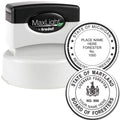Have you ever tried to label a favorite sweatshirt or your kid’s soccer jersey, only to find the ink smudged or washed away days later? That’s where a permanent clothing marker steps in. With the right marker, you can quickly label garments, uniforms, and personal belongings without worrying about fading or accidental blotches. It’s a small tool that can save you big headaches, especially when everyone in your house wants to keep track of their clothes.
Below, you’ll discover how to pick a reliable marker, the best ways to use it, and what to do if you’re craving an alternative option that’s just as simple. Let’s explore all the tips, from selecting features to maximizing longevity, so you can say goodbye to errors and hello to lasting labels.
Recognize the Value of Permanent Clothing Markers
A permanent clothing marker is designed to stand up against routine washing and heavy wear. Unlike regular markers that might fade in a couple of cycles, these specialized tools hold their color on cotton, polyester, and a variety of other fabrics.
Why do you need one? Well, if you share laundry space, run a daycare, have kids in sports teams, or simply want to keep yourself organized, labeling garments with a pen that won’t wash out is a huge time-saver. You’ll know at a glance which shirt belongs to whom, and no mystery sock will ever go unclaimed again.
Another plus is the flexibility these markers bring. You’re not limited to writing on size tags or hidden corners. You can write directly on fabric, mark discreetly near a side seam, or even place a tiny dot somewhere only you’ll notice. As long as you’re mindful of where you place the mark, your labels can remain neat while still being legible.
Where Permanent Clothing Markers Really Shine
- School uniforms, gym clothes, or practice jerseys
- Camp gear or travel outfits
- Team sports apparel that includes jackets, hats, and gloves
- Senior living facilities, where proper labeling prevents mix-ups
- Everyday items like towels, bedding, or tote bags
Making life easier is the key. And by switching to a sturdy garment-marking solution, you stop the endless rewriting or re-labelling routine.
Explore Key Features
Not all fabric markers are created equal. Before you buy, it helps to know what to look for in terms of drying time, ink properties, and tip design.
Drying Time
A marker that dries quickly lets you move on with your day without hovering over freshly labeled laundry. As soon as you finish labeling, you ideally want to toss your garments into a bag or hamper without smudging. Check for markers boasting “quick-dry” or “no-bleed” technology.
Ink Properties
Some inks are water-resistant, while others are fully waterproof. Dim or faint text can defeat the purpose of labeling your clothes in the first place, so opt for a pen that delivers bold, crisp marks. If you suspect your items will undergo frequent washing, go for a marker rated for durability through multiple wash cycles.
Tip Design
Markers come with different tips: fine, medium, or thick. Fine tips are fantastic for writing names or initials on small tags, whereas broader tips can handle large designs or thick lettering. If you’re primarily labeling children’s clothing tags, a fine tip often works best.
Handy Overview
Below is a quick look at typical features you might see:
| Feature | Why It Matters |
|---|---|
| Quick-Dry Ink | Prevents smudges and saves time |
| Water-Resistant | Sticks around after many wash cycles |
| Fine Tip | Allows precise writing on small areas |
| Bold Tip | Great for big labels or thicker lines |
When you’re in a hurry or juggling multiple to-dos, you want a marker that’s simple, dependable, and stays put. By checking these core features, you can pick a product that meets your needs and spares you the agony of redo after redo.
Follow Simple Labeling Steps
Using a permanent clothing marker isn’t rocket science. But a few small tricks can pay off by extending your label’s lifespan.
Pre-Wash the Item
If time allows, give the item a quick wash and ensure it’s fully dry. This step removes any chemicals or residual finishes, helping the ink bond more effectively.Choose a Sturdy Surface
Flatten the fabric on a hard surface like a table or countertop. This helps your marker glide on smoothly and ensures your letters or numbers don’t come out crooked.Label in a Visible Spot
Aim for the inside tag if you want to keep the writing discreet, or go for the neckband or hem if easy identification is your priority. Press lightly at first and outline the text so you can correct any shaping issues.Let the Ink Dry
Wait a few seconds or up to a minute, depending on the directions on your specific marker. Quick-dry formulas typically only take a few seconds, but it never hurts to be cautious.Test for Smudging
Gently run your finger across the marked area. If ink appears on your finger, give it more time. Once dry, the label should look sharp and feel dry to the touch.
A Note on Forced Drying
Avoid using a blow dryer or direct heat. While it might seem like a shortcut, heat can affect ink adherence. Follow the product’s instructions or let it stand on its own, and you’ll get a more dependable result.
Prevent Common Pitfalls
Even the most careful person can run into hiccups. If you’re labeling garments for the first time, here’s how to steer clear of common mistakes:
-
Over-Labeling
Writing too big or adding multiple layers of ink can cause bleeding. Keep your text concise and let the pen do its job with a single pass or two. -
Unstable Surfaces
Marking clothes while they’re bunched up on your lap or while you’re on the couch often leads to shaky lettering. Find a stable surface before you start labeling. -
Rushing the Drying
It’s tempting to label everything at once and immediately toss your shirts in the hamper. But if you don’t allow proper drying, you might see blurry or slanted text. -
Ignoring Wash Instructions
Different fabrics have different care guidelines. If the garment label says “Delicate Cycle Only,” it’s still best to follow that routine to preserve both your clothes and the ink.
What to Do If Something Goes Wrong
- Smudge: Dab gently with a cloth, but don’t rub excessively. You may need to re-apply the ink in a cleaner spot.
- Bleed: Let the area fully dry and see if the letters are still legible. In some cases, you might outline over the original text with a fine tip for clarity.
- Faint Mark: Go over it once more after it’s completely dried. Adding multiple coats in quick succession can blur your writing.
Consider a Fabric Stamp
Sometimes, you might want an alternative to handwriting everything. That’s where a fabric stamp comes in handy. Picture a neat, uniform imprint of your name or a simple icon—no struggling with shaky handwriting or spelling mistakes at the last moment.
- Stamps offer consistent results every time.
- They reduce hand strain because you’re just stamping, not writing letters over and over.
- You can create personalized designs or logos in seconds.
- Ink is typically quick-drying and formulated specifically for fabrics.
The beauty of a stamp is how it combines speed and efficiency. And if you’ve got more than a few clothing items to label—think kids at summer camp or a busy sports team—stamps can be a lifesaver. They also let you maintain a uniform look across all your items without worrying about differences in handwriting.
Meet ESS, Your Labeling Partner
Labeling shouldn’t be complicated. If you’re searching for top-quality cloth marking supplies, you’ll love what ESS has to offer. We’re a family-owned company that’s been helping folks label their belongings since 1964. With 60 years of dedicated service, we’ve pretty much seen it all—faded names on T-shirts, smudged labels on uniforms, and way too many mismatched socks.
At ESS, we take pride in:
- Offering an array of cloth marking stamps, permanent markers, and more
- Providing stellar customer service that actually cares about your labeling challenges
- Delivering super fast turnaround times, so you’re never left waiting
- Building on decades of experience to ensure consistent, high-quality products
Whether you go with a classic pen or a custom stamp, we’re here to support you. Our team is always just a message away if you need guidance or have questions about the best product for your unique needs.
Why Trust a Long-Standing Brand?
We know the market is crowded. But being family-owned for nearly 60 years means we’ve had the time to perfect the balance of quality and value. ESS was built on genuine customer relationships, and we continue that tradition every single day. When you call, you’ll speak to someone who understands these products deeply and will take the time to advise you, so you get precisely the solution you want.
Get Answers to FAQs
Below are some of the most common questions people have about using a permanent clothing marker or switching to a cloth marking stamp. Check these out before you make your final move.
1. Will the Ink Bleed in the Wash?
Permanent fabric inks are designed to withstand multiple washes without bleeding. However, making sure the ink is fully dry before the first wash is crucial. If you notice any fading, wait until the clothes are 100 percent clean and dry, then touch up the label carefully.
2. Is It Safe for Delicate Fabrics Like Silk?
Most permanent clothing pens and stamps work fine on delicate fabrics, but check the manufacturer’s guidance. It’s often recommended you test on a small, hidden area first to ensure the ink won’t bleed or alter the fabric’s color.
3. How Do I Avoid Hand Cramps When Labeling Many Items?
Doing a bulk labeling session? Take short breaks or consider using a stamp. A fabric stamp can speed things up and prevent fatigue since you’re just pressing once per item instead of writing out multiple names.
4. What Happens If I Make an Error?
It’s permanent ink, so there’s no guaranteed fix without potentially damaging the fabric. However, if the mark is small, you can try covering it with a patch or new label. Another trick is to write a corrected label next to it and mark the incorrect label with a simple line, so it’s not confused as the real one.
5. Will the Marker Work on Dark-Colored Clothes?
Yes, if the ink is opaque or labeled for dark fabrics. Keep in mind that standard black markers might not show well on dark blues or blacks. Look for white or metallic fabric markers specifically labeled for use on dark materials. If you prefer a fuss-free option, a high-contrast stamp could be your friend.
By now, you should feel confident about choosing and using a permanent clothing marker or a fabric stamp. The aim is clear: to label everything from your cozy sweaters to your kid’s soccer socks without the fear of watching those labels fade away. Whether you’re a first-timer or you’ve tried other markers before, picking a dependable product is worth the peace of mind.
Best of all, if you still have questions, ESS is here to help. We take pride in solving labeling conundrums, whether it’s for a household of five or a team of twenty-five. Ready to avoid another laundry mix-up? Grab your marker or stamp, flip your shirt inside out, and mark it with confidence. Your labeled items will stay put, and the dreaded “Whose sock is this?” conversation may finally become a thing of the past.


















